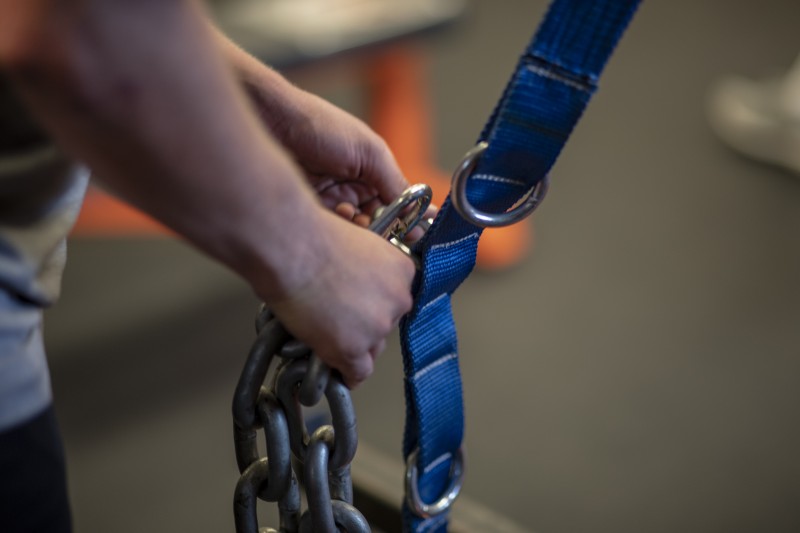
This is the time of year that presents unique challenges for us. We get in a new crop of athletes and need to teach them how we do things. It’s not so hard if you have them there for the majority of the summer. They can learn from you and their teammates and get a pretty clear understanding of how things are run. The challenge is trying to establish your culture for athletes who arrive on the first day of training camp. The luxury of just working out is gone, replaced with kids who are away from home for the first time. They have to deal with new teammates, coaches, trainers, playbooks, practice, and an actual schedule they need to follow. The list goes and on and on. It’s like trying to drink from a fire hose! After they are completely swimming, then you and your staff have the pleasure of working them out!
RECENT: Building A Summer Training Philosophy
To an outsider, things may seem easy during camp as far as being a strength coach goes. You have them maybe a half hour to forty-five minutes a day if you’re lucky. Easy peasy, right? Wrong! That could not be further from the truth. This is by far the most stressful time for me and pretty much all strength coaches. Think about it: You have just had eight blissful weeks of lifting, running, and establishing your culture on a daily basis without interference: no coaches, no full class schedule, and no distractions. It’s the best time of the year by far—you are basically the head coach without the salary. Then comes training camp, and the role of a strength coach goes from the top of the ladder to the bottom in a heartbeat. Meetings and practice take the lead role (as they should at this time of the year). After the first day, these kids are physically and mentally beat up, and after a week, they are pretty much the walking dead. The key to being a good strength coach is figuring out how to navigate this minefield as it becomes the ultimate balancing act. Designing workouts for camp is easy; implementing them is another thing. Let me tell you why. Here are some of the factors we have to cover every day before putting these workouts into effect, and the answers can change up to the minute.
Dehydration
Are you getting the kids right after practice? Have they been hydrating and eating the way they should? There is nothing like a full-body cramp to really put a damper on a workout. This is where your relationship with your trainer is so important. Daily weigh-ins and weigh-outs are imperative from day one to the end of camp. It will red-flag almost all of the potential cramping issues you will face and will help you all to keep an eye on who to keep an eye on. Cramping is almost 100% preventable with the right nutrition and fluid intake, but some players need their own specific plans. Know what these plans are, and help them to follow them as much as possible. Camp is all hands on deck—don’t shy away from helping out in this department.
Injuries
This area constantly changes during camp, and it is a part that you and your staff have to be aware of hour by hour. There are old injuries, nagging injuries, new injuries, and my favorite—the ones that pop up unexpectantly right as the lift begins. We are constantly changing exercises to help our players to work around their injuries. This is one of the two most important ways you can earn the trust of your team. Giving athletes alternate exercises to do instead of making them do the original ones “because that is what is on the sheet” will show them that you understand what they are going through. In other words, you know what the hell you are doing. Pretty important. I know that you are also going to point out that some of these players may be tired, suck it up, etc. I have a few things to say on this matter, and it has definitely changed the longer I have been doing this. If a player is faking an injury, it is the trainer’s decision to verify it, not yours. These are battles that can be fought at any other time of the year, and it should always be hashed out between the position coach and the player. Trust me, after 20 years, I have seen and heard it all when it comes to this area, and those kids never last. The trainer and the strength coach tells the kid to work out, and he doesn’t. Just report it to his coach and move on. He approved and recruited him, so let him get crazy about his mistake, not you. Players like that will not be in your program for long.
Team Status
This is the second most important way to up the trust your team has in you, and it is both an art and a science. I define “team status” as where the team members really are both physically and mentally. I was introduced to this in my first college job. We had a staff meeting every day at 1:00, and one of the first things our head coach would do was go around the table asking “What do you think—where are the players and what should we do this afternoon (or next morning)?” The whole staff would then give their opinions on the status of the team. Were they just tired and could push through, were they really tired and should we back off, shells or full pads, helmets? We all gave our opinions, and he then made his decision on the direction we should go for the next practice. It has stuck with me, and we as a strength staff do this every day before the workout. There are days when they gotta push through, and there are days you gotta pull back. Follow whatever parameters you have set up for your own individual team, and listen to them. As a last resort, listen to your gut.
I know you have a lot to implement, especially for the new players who were not there all summer, and you don’t want to come off as “soft.” But if you teach them one thing during camp—to trust you—you really don’t have to teach them anything else. It will all be easy from there. Hope this helps, and wishing all a healthy and productive training camp!












1 Comment